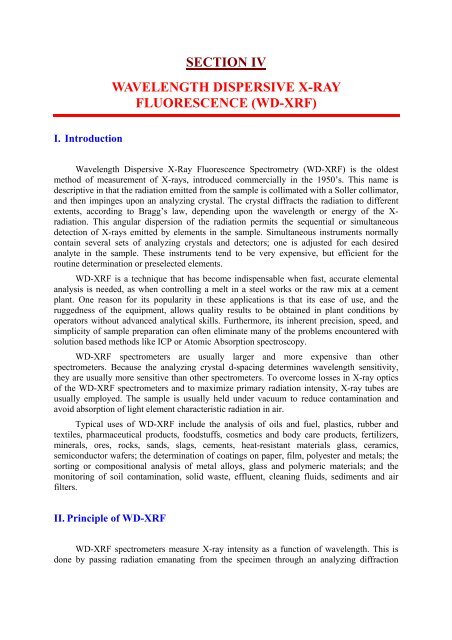X-Ray Fluorescence Analytical Techniques - CNSTN : Centre ...
X-Ray Fluorescence Analytical Techniques - CNSTN : Centre ...
X-Ray Fluorescence Analytical Techniques - CNSTN : Centre ...
You also want an ePaper? Increase the reach of your titles
YUMPU automatically turns print PDFs into web optimized ePapers that Google loves.
I. Introduction<br />
SECTION IV<br />
WAVELENGTH DISPERSIVE X-RAY<br />
FLUORESCENCE (WD-XRF)<br />
Wavelength Dispersive X-<strong>Ray</strong> <strong>Fluorescence</strong> Spectrometry (WD-XRF) is the oldest<br />
method of measurement of X-rays, introduced commercially in the 1950’s. This name is<br />
descriptive in that the radiation emitted from the sample is collimated with a Soller collimator,<br />
and then impinges upon an analyzing crystal. The crystal diffracts the radiation to different<br />
extents, according to Bragg’s law, depending upon the wavelength or energy of the Xradiation.<br />
This angular dispersion of the radiation permits the sequential or simultaneous<br />
detection of X-rays emitted by elements in the sample. Simultaneous instruments normally<br />
contain several sets of analyzing crystals and detectors; one is adjusted for each desired<br />
analyte in the sample. These instruments tend to be very expensive, but efficient for the<br />
routine determination or preselected elements.<br />
WD-XRF is a technique that has become indispensable when fast, accurate elemental<br />
analysis is needed, as when controlling a melt in a steel works or the raw mix at a cement<br />
plant. One reason for its popularity in these applications is that its ease of use, and the<br />
ruggedness of the equipment, allows quality results to be obtained in plant conditions by<br />
operators without advanced analytical skills. Furthermore, its inherent precision, speed, and<br />
simplicity of sample preparation can often eliminate many of the problems encountered with<br />
solution based methods like ICP or Atomic Absorption spectroscopy.<br />
WD-XRF spectrometers are usually larger and more expensive than other<br />
spectrometers. Because the analyzing crystal d-spacing determines wavelength sensitivity,<br />
they are usually more sensitive than other spectrometers. To overcome losses in X-ray optics<br />
of the WD-XRF spectrometers and to maximize primary radiation intensity, X-ray tubes are<br />
usually employed. The sample is usually held under vacuum to reduce contamination and<br />
avoid absorption of light element characteristic radiation in air.<br />
Typical uses of WD-XRF include the analysis of oils and fuel, plastics, rubber and<br />
textiles, pharmaceutical products, foodstuffs, cosmetics and body care products, fertilizers,<br />
minerals, ores, rocks, sands, slags, cements, heat-resistant materials glass, ceramics,<br />
semiconductor wafers; the determination of coatings on paper, film, polyester and metals; the<br />
sorting or compositional analysis of metal alloys, glass and polymeric materials; and the<br />
monitoring of soil contamination, solid waste, effluent, cleaning fluids, sediments and air<br />
filters.<br />
II. Principle of WD-XRF<br />
WD-XRF spectrometers measure X-ray intensity as a function of wavelength. This is<br />
done by passing radiation emanating from the specimen through an analyzing diffraction


